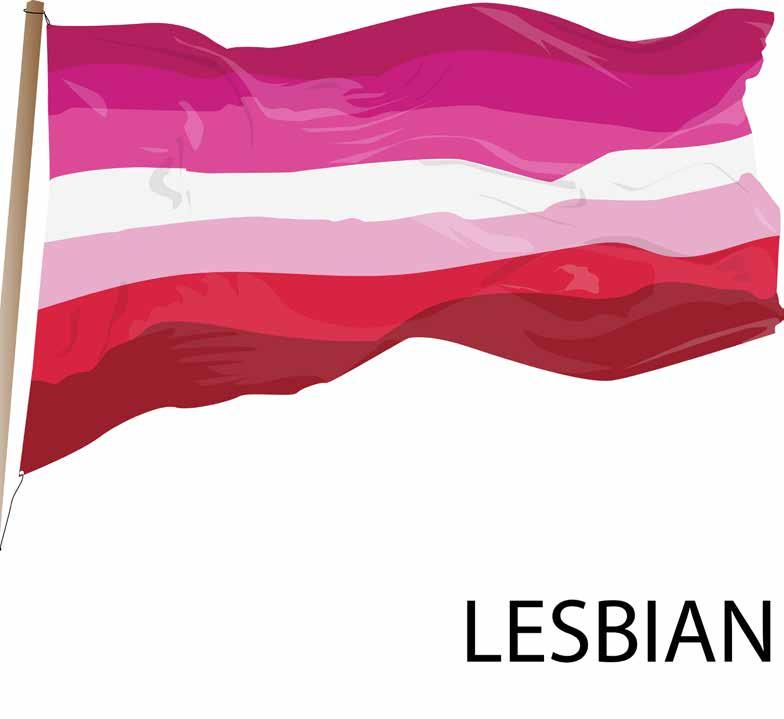
4 minute read
FLAGS
LESBIAN FLAG IS MOST POPULAR IN THE UK!
FLAG MAKERS HAVE BEEN DOING some research on Google Search Trends to find out which LGBTQ+ flag is the most popular in the UK right now. The analysis gave them some insightful knowledge and showed that in fact the Lesbian flag is the most popular with 32,160 Google searches in the past year. They have a created a top 15 list of popular flags in the UK; including explaining each flag on their site!
Top 15 list
Rank LGBTQ+ Flags Google Searches 1 Lesbian Flag 32,160 2 Bisexual Flag 26,832 3 Asexual Flag 25,824 4 Pansexual Flag 22,596 5 Pride Flag 21,216 6 Straight Flag 20,592 7 Transgender Flag 19,236 8 Polyamorous Flag 13,308 9 Straight Ally Flag 12,708 10 Non-Binary Flag 12,168 11 Progress Flag 11,976 12 Gender Fluid Flag 10,524 13 Intersex Flag 8,928 14 Polysexual Flag 7,632 15 Pony Flag 6,540 Wondering what each flag represents? Here’s Flagmakers’ guide to pride!
Lesbian Flag
This flag features various shades of pink, white and red to represent women - the colours also represent the independence from men.
Bisexual Flag
This flag was created to give further recognition to bisexual people within the LGBTQ+ community. The lovely thing about this flag is that the stereotypical colours for men (blue) and women (pink) overlapped together creating a purple.
Asexual Flag
This flag acts as an emblem and identifier for people who have a lack of sexual attraction to all genders, the flag also incorporates the colour purple to represent the wider LGBTQ+ community and the place Asexual people have there. The black and grey stand for asexuality and demi-sexuality, whilst the white represents non-asexual partners and allies for the
Pansexuality Flag
Pansexuality means an interest in all genders which is why there is a distinct yellow in the middle of this flag to represent non-binary and gender non-conforming people. The magenta stripe represents attraction to those who identify with a female spectrum, the cyan for those who identify on the male spectrum.
Pride Flag
The most known LGBTQ+ flag known worldwide; this is the symbol used by pride parades and LGBTQ+ organisations to represent the history and achievements of the fight for equality. The rainbow design was inspired by Judy Garland’s ‘Over the Rainbow’ and each colour stands for a different component of LGBT life.
Straight Flag
To celebrate heterosexualty, but what is key about this flag is that it is black and white to represent every person no matter the race.
Transgender Flag
Both stripes at the bottom and the top are light blue to represent the traditional colour for baby boys along with the light pink stripes to represent baby girls. There is a white stripe in the middle for those who are intersex, transitioning or who consider themselves having a neutral or undefined gender. What is interesting about the stripes on the flag is that no matter which way you hold the flag up, it is right.
Polyamorous Flag
This flag features the symbol for the infinite number pi, which shares the first letter of ‘polyamory’. This flag celebrates the infinite selection of partners available to polyamorous people. The letter is gold to represent the emotional attachment we have with others as friends and romantic partners.
Straight Ally Flag
This flag is a combination of various symbols, including the straight flag, the traditional rainbow pride flag. The merging of the two is meant to show allyship for the LGBTQ+ community.
Non-Binary flag
The non-Binary flag was created to fly alongside the genderqueer flag with the hope to be more inclusive. It was designed as a symbol of pride and recognition for those whose gender identity does not fit within the traditional male/ female binary. The yellow stripe stands for those who fall outside of and without reference to the binary. White is for those with many or all genders and black for those who do not conform to gender normative labels. The purple stripe represents those who identify as a mix of or somewhere between the male and female spectrum.
Progress Flag
This flag shows support and solidarity with marginalised groups, even within the LGBTQ+ community, this design was adopted following a viral Kickstarter campaign. By adding the chevron to the traditional six-colour design, the designer wanted to highlight the further struggles of queer people of colour, those living with HIV/AIDS, and persons in the trans community.
Gender Fluid Flag
The gender fluid flag features colours commonly associated with femininity, masculinity and everything in between. The pink stands for femininity, blue for masculinity, the white represents the lack of gender and the purple just like it’s featured on the bisexual flag represents the combination of both masulinity and femninity. Finally the black symbolises all genders.
Intersex Flag
This flag purposely avoids the use of the traditional pink and blue to represent people who are born with a reproductive/sexual anatomy that doesn’t seem to fit the typical definition of male or female. The yellow background stands for gender neutrality and the purple circle is depicted as unbroken and unornamented, symbolising wholeness and completeness.
Polysexual Flag
Polysexuality is the attraction of multiple genders but not all of them, it is the middle ground between bisexualtiy and pansexuality; so it is centred more around attractions to femininity and masculinity rather than gender itself. The distinct green stripe in the middle of the flag represents an attraction to those who don’t conform to either gender.
Flag Makers: https://flagmakers.co.uk/blog/ resources/lgbtq-pride-flags-and-their-meanings/
YOU!











